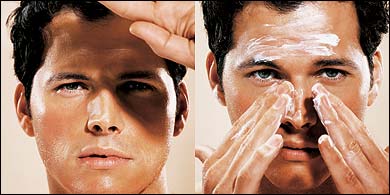YOU’D THINK avoiding sunburn would be pretty simple: Spread lotion all over your bod and go, right? But when you wander down the sun-protection aisle in the drugstore, you face an overwhelming array of goos, sprays, gels, and lotions—some available in five different SPFs, some hyping waterproof formulas, and some doubling as moisturizers. All claim to protect your skin from damage caused by the sun’s ultraviolet rays, thereby reducing your chances of contracting skin cancer or getting wrinkles prematurely.
But if the goals are identical, what’s the difference? And how do you decide which sunscreen is best for you? Though the choices seem bewildering, you can make a smart selection by understanding what sun protection factor (SPF) ratings really mean and what the various active ingredients actually do once you smear them on your hide.
Let’s start with the inherently confusing SPF numbering system. Most of us assume SPF 45 is three times stronger than SPF 15, but in fact it’s only about 5 percent more potent. An SPF 15 product blocks roughly 93 percent of UVB rays; SPF 30, 97 percent; and SPF 45, 98 percent. This matters because many people wrongly assume that high-SPF sunscreens render the wearer invulnerable to sun damage and need to be applied only once a day.
The fuzzy math of the SPF rating system can be blamed partly on the Food and Drug Administration’s sub-par labeling standards. “I don’t think it’s intentional,” says Shawn Allen, a dermatologist at Washington University School of Medicine, in St. Louis. “But the FDA has made it possible for the consumer to believe they’re getting substantially more protection than they really are.”
The good news: The FDA recently introduced labeling regulations that make “SPF 30+” the highest number manufacturers can claim, while also requiring them to specify the frequency with which sunscreens should be applied. (Most labels now say to apply “as needed.”) The bad news: The agency is a slow-moving beast, and now they want to add more standards to the label. Regs that were supposed to be in force as of 2001 likely won’t be enforced until 2009.
Choosing an SPF (see “Screen Savers,” on the next page, for some of the best) is just one part of a successful skin-defense strategy. The rest depends on which type of sun protection you buy, how you apply it, and where you use it. Follow the tips below and you should make it to Labor Day and beyond without feeling the burn.
» Block both UVA and UVB rays with what’s called a broad-spectrum sunscreen (look for the words BROAD SPECTRUM and UVA/UVB on the label).
» Know your formulations. Chemical sunscreens absorb light rays and generally look and feel oily. Effective chemical ingredients include avobenzone (Parsol 1789), menthyl anthranilate, and dioxybenzone. Physical sunblocks deflect light; they usually contain zinc oxide or titanium dioxide and typically go on thick and white. The best sun-protection products contain both chemical and physical blocks, because different ingredients block different slices of the light spectrum, some last longer than others before breaking down from exposure, and others shed water more easily.
» Slather on twice as much sunscreen as you think you need, at least 20 minutes before stepping outside. That’s how long skin needs to absorb the stuff. Reapply every two hours—after which the chemicals have lost their UV-battling power.
» Water-resistant sunscreens are tested to last up to 40 minutes, while waterproof and sweatproof formulas do the job for up to 80 minutes. Oil up after a swim, since toweling off will, of course, remove your sun lotion.
Screen Savers
Burn blockage comes in a host of forms, and each concoction is suited for different activities or needs. Here are some of the best, with tips on when, where, and how to use them.

Clockwise from top:
HIMAYA’s SPORTS SUN PROTECTION (SPF 30) dries quickly when you rub it into your skin, leaving no residue; plus it exceeds the FDA’s requirements for waterproof sunscreen—a boon to surfers, swimmers, and boaters. 6 oz, $15;
Not even a sweat bath can remove a smear of PRODERMA FACE STICK (SPF 30). Its waxy texture might take some getting used to, but swimmers and people who perspire heavily will reap big benefits from this thick sunblock. 0.5 oz, $6;
Skin protection shouldn’t stop once you head indoors. A dollop of KISS MY FACE AFTER SUN ALOE SOOTHER, with its aloe vera, yucca glauca root, and jewelweed, will cool and moisturize sun-sore skin. 4 oz, $6;
SKINCEUTICALS SPORT UV DEFENSE (SPF 45) uses a translucent formulation of zinc oxide, so you won’t look like you’re wearing white paste. Best for daily protection. 3 oz, $34;
The 18.5 percent zinc-oxide formula used in OBAGI’s NU-DERM PHYSICAL UV BLOCK (SPF 32) makes it the right choice for high-exposure spots like the face and for high-elevation activities that call for stronger protection. 2 oz, $38;
Cyclists and climbers who don’t want to get their hands greasy should turn to KINESYS PERFORMANCE SUNSCREEN (SPF 30+), an alcohol- and oil-free spray packed with Parsol 1789 that goes on dry. Since you don’t have to rub it in, it easily covers hard-to-reach spots. 4 oz, $14;


